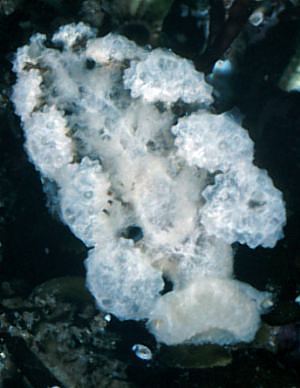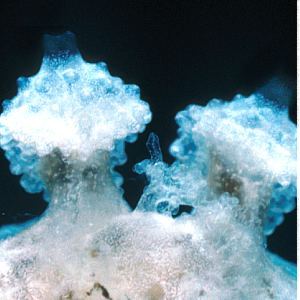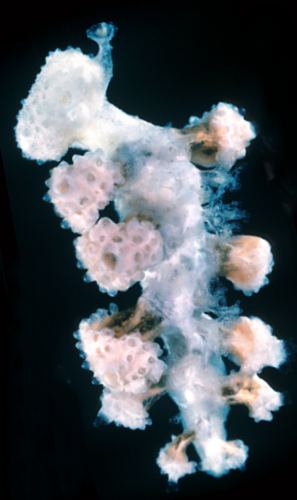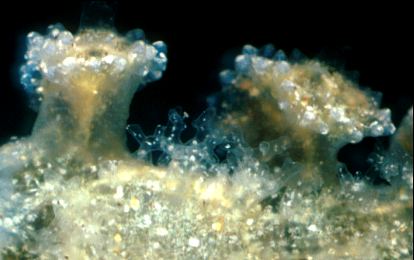
Melibe australis
Angas, 1864
Order: NUDIBRANCHIA
Suborder: DENDRONOTINA
Family: Tethydidae
DISTRIBUTION
Temperate Australia from Cape Naturaliste, Western Australia. to northern New South Wales, from the lower intertidal to 10 m deep.
PHOTO
Data: Arrawarra Rock platform, Woolgoolga, Northern New South Wales. 3 Dec 1990 At LWS. Numerous specimens (approx. 28 mm long) AM C164561. Photos: Bill Rudman
Body slender, up to 30 mm in length, soft, high, rounded with dendritic papillae covering the notum. There are usually 5 pairs of cerata. The stalked cerata have a characteristic flask-like shape, the bottom half being smooth and concave and the upper half being papillate and rising to a central apical papillae [lower left photo]. papillae restricted to the dorsal side. The cerata are easily autotomised. The oral hood is relatively small and rounded in shape. The small rhinophores have a elongate sheath. the animals showed a huge range of colour, some of which is illustrated here. Some were transparent with a few brown & white specks. Others have opaque white, pink or orange pigment on the dorsum and the flat outer surface of cerata. The oral hood similar in colour to dorsum. When resting, with the stalked cerata 'tucked in', the opaque pigmented specimens look just like ascidian colonies [see separate message]. When sitting, the oral veil is held antero-dorsally, and the front of the foot is conical, like the tail.
The species is the smallest in the genus. It produced a strong smell when handled which has been described variously as sweet and musky to strong and acrid. They are usually found either under rocks on the lower shore in areas where brown algae are the dominant algae, or on brown algae.
The photos show a typical specimen [upper right] which is translucent white with little pigmentation, and an animal with a heavy covering of opaque pink pigmentation [lower right].
Reference:
• Angas, G. F. (1864) Description d'especes nouvelles appartenant a plusieurs genres de Mollusques Nudibranches des environs de Port-Jackson (Nouvelle-Galles du Sud), accompagnee de dessins faits d'apres nature. Journal de Conchyliologie, series 3, (12): 43-70, pls. 4-6.


Rudman, W.B., 2003 (February 26) Melibe australis Angas, 1864. [In] Sea Slug Forum. Australian Museum, Sydney. Available from http://www.seaslugforum.net/find/meliaust
Related messages
Dextral egg spirals in Melibe australis
March 6, 2003
From: Irina Roginskaya

Dear Bill,
Thank you for beautiful photos of dextral spawns of Melibe from the Southern Hemisphere! Are the spirals really dextral? The photo is not turned over?
Irina.
irina7@hotmail.com

Dear Irina,
I have checked the slides and my field notes and yes the egg ribbon does spiral dextrally. Here are a couple more photos of the same eggs, in the upper photo there is a third distintegrating [mature?] egg mass in the right foreground. The egg ribbons had a diam of approx 7mm.
Arrawarra Rock platform, Woolgoolga, northern New South Wales. 3 Dec 1990 At Low Water Spring. AM C164561. Photos: Bill Rudman
I must confess I had not noticed the dextral coiling. Certainly an interesting observation. It got me hunting for other photos of Melibe egg ribbons. I have found one of Melibe engeli which also spirals dextrally!
Best wishes,
Bill Rudman
Melibe australis - another colour variant
March 2, 2003
From: Bill Rudman


Here is another colour variant of Melibe australis.
Photo: Arrawarra, northern New South Wales, Australia under rocks at extreme low tide, 3 November 1982. 23mm long alive. AM C136167. Photos: Bill Rudman.
This is a translucent brown specimen with opaque white spots. The ramifications of the digestive gland are visible in the bottom half of cerata. The stalked cerata have theh chracteristic 'top'-like shape, with papillae restricted to the dorsal side. The cerata are easily autotomised. A large dorsal blood vessel can be seen in living animals running down the dorsal midline with branches to all the dorsal gills.
Best wishes,
Bill Rudman
Melibe australis from Woolgoolga, northern NSW
March 1, 2003
From: W.B.Rudman

As promised earlier, here are some photos and information on the southern Australian species Melibe australis. As you will see from other messages, it seems possible there is more than one relatively small species around temperate Australia.
Photos:: Arrawarra Rock platform, Woolgoolga, Northern New South Wales. 3 Dec 1990 At LWS. Numerous specimens(approx. 28 mm long) AM C164561. Photos: Bill Rudman
The animals produced a strong acrid smell when disturbed. They were found under rocks on the lower shore in areas where brown algae are the dominant algae. There were many egg masses and the animals showed a huge range of colour, some of which is illustrated here. Some were transparent with a few brown & white specks. Others have opaque white, pink or orange pigment on the dorsum and the flat outer surface of cerata. The oral hood similar in colour to dorsum. There were usually 5 pairs of cerata (last very small). When resting, with the stalked cerata 'tucked in', the opaque pigmented specimens look just like the ascidian colonies of the same colours - found just a little further up the shore. When sitting, the oral veil is held antero-dorsally, and the front of the foot is conical, like the tail.
The photos show a typical specimen [upper right] which is translucent white with little pigmentation, a specimens with some yellow and white specks [lower left] and an animal with a heavy covering of opaque pink pigmentation [lower right]. In a separate message are photos showing the remarkable resemblance the cerata, of animals with opaque pigmentation have to the compound ascidians living on the shore.
Best wishes,
Bill Rudman


Melibe australis - ascidian mimic
March 1, 2003
From: Bill Rudman

In specimens of Melibe australis without much pigmentation, it is difficult to see the characteristic shape of the cerata in this species. The cerata are stalked and flask-shaped or top-shaped [see lower left photo]. While the underside of each ceras is smooth, the dorsal side is covered in large transparent papillae which often appear to be invisible because of their transparency. In animals with a bright opaque background colour, such as the orange one in the upper right photo, the cerata seem to be covered in wide holes similar to the oscules of sponges or siphonal openings of ascidians. This is an optical illusion, each white-ringed 'hole' being in fact the base of a transparent papilla or elongate tubercle.
When the animals are not crawling, and the cerata are tucked together, they have a remarkable resemblance to to orange, pink and whitish colonies of a compound ascidian also found on the shore at Arrawarra. A photo of it can be seen at the top of the Velutinidae Fact Sheet.
Photos:: Arrawarra Rock platform, Woolgoolga, Northern New South Wales. 3 Dec 1990 At LWS. Numerous specimens (approx. 28 mm long) AM C164561. Photos: Bill Rudman
Best wishes,
Bill Rudman


Melibe australis - egg ribbon
March 1, 2003
From: Bill Rudman

To accompany my earlier messages, here is a photo of the egg mass of Melibe australis
Photos:: Arrawarra Rock platform, Woolgoolga, Northern New South Wales. 3 Dec 1990 At LWS. Numerous specimens (approx. 28 mm long) AM C164561. Photos: Bill Rudman
Best wishes,
Bill Rudman
